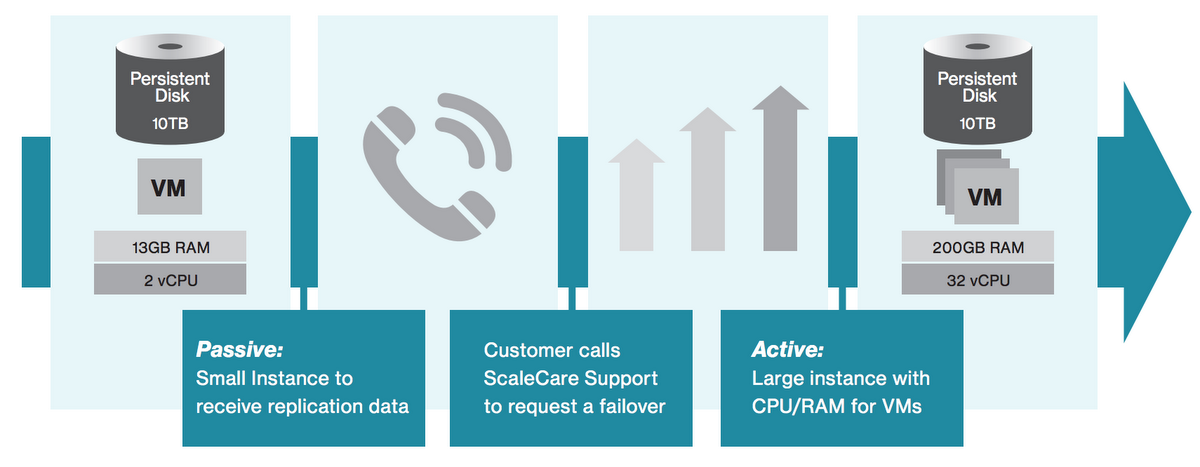Scale Computing: Using hyperconverged infrastructure and cloud together for flexible DR
Jeff Ready
CEO and co-founder of Scale Computing
[Editor’s note: We’re always interested in seeing different ways businesses use cloud services within their infrastructures. Today we’re hearing from Scale Computing, whose hyperconverged infrastructure platform automates away management tasks and lets IT teams scale faster with better systems availability. Their disaster recovery as a service (DRaaS) option brings in the benefits of Google Cloud as a quickly available failover destination for production VMs. Read more about how Scale operates DR at remote locations.]
For years, cloud backup and co-locations have been a popular way to help fortify disaster recovery strategies, but as IT professionals know all too well, hybrid cloud architectures and solutions can be complex and costly. At Scale Computing, we wanted to simplify this, so we introduced Scale HC3 Cloud Unity, a DRaaS solution that helps connect on-premises data and cloud infrastructures. This means you can add disaster recovery capabilities to your remote locations, without IT resources on-site and without a lot of setup needed.
Here’s how it works.
5 steps to setting up a cloud-based DR site
1. ScaleCare Services deploys a remote HC3 system instance on Google Cloud Platform (GCP) in passive mode with a small footprint of 13GB of RAM and 2 vCPUs. This small footprint helps reduce the overall cost of the solution, but still offers enough resources to spin up a VM or two for testing purposes, depending on what’s best for your situation.
2. ScaleCare Services deploys a gateway on-premises at the location of your choice to create a Layer 2 tunnel using VXLAN to connect to the remote HC3 cloud instance.
3. On a per-VM basis, the HC3 administrator can configure replication using the user-configurable schedules feature to the remote HC3 cloud instance.
4. If a disaster is declared by the HC3 administrator, ScaleCare Services changes the remote HC3 instance from passive to active mode and resizes it to accommodate all of the VMs that are failed over. The gateway allows end users to rapidly reconnect to VMs that fail over from the on-prem HC3 system to the remote HC3 cloud instance. If the gateway is also affected by the disaster, it can be quickly recreated at any location that has an internet connection.


As shown here, the passive instance requires a few cores and a small amount of memory. This is the standard mode for replicating data. The active instance has more cores and memory and is designed to run production workloads.
5. Once the on-prem HC3 system has been restored to functional capacity, data can be replicated back to the on-prem HC3 system. Then, you can fail VMs back and redirect users. Once failback is complete, ScaleCare Services will change the remote HC3 instance back to passive mode.
ScaleCare Services works directly with HC3 administrators during initial setup to create a disaster recovery runbook to guide the process in the event of a disaster and to make sure workloads come back online as quickly as possible.
You can learn more about this in the HC3 Cloud Unity DRaaS Theory of Operations.
Benefits of cloud-based DRaaS
Using a cloud-based solution for disaster recovery offers a number of benefits:
A practical DR site
Not all organizations have a remote site and for those that do, the remote site may not be suitable for disaster recovery. GCP is a secure, reliable, remote location that’s always on and helps ensure the recoverability of workloads.
Protection from regional disaster
GCP spans geographical regions, so you can protect your workloads in regions outside of the on-prem HC3 system and can choose locations based on your requirements.
Predictable costs
As a hosted service, cloud-based DRaaS protects workloads at a contracted monthly rate. Without large upfront capital expenses, it’s easier to budget and maintain.
As you’re building a resilient infrastructure, using cloud services strategically can open up new ways to be more efficient, save money and protect all the workloads and data that your users need. Find out more here about how HC3 Cloud Unity DRaaS works.

